Postcards from the Field September 2007
As part of the 200th Celebration, we have asked staff from around NOAA to send in their "Postcards from the Field." A "postcard" is a photo from a NOAA field office, science center, or any site on the globe where NOAA is conducting research or field work. The postcard includes—anywhere in the shot—a NOAA 200th emblem or banner.
For more information about "Postcards from the Field," including details about how to participate, please contact David.P.Miller@noaa.gov.
This creative collection of images showcases the breadth and span of NOAA's work...whether it involves conducting research at the South Pole, surveying the ocean floor in Alaska, or flying into hurricanes, NOAA is there. Click on the arrows to browse through postcards submitted thus far.


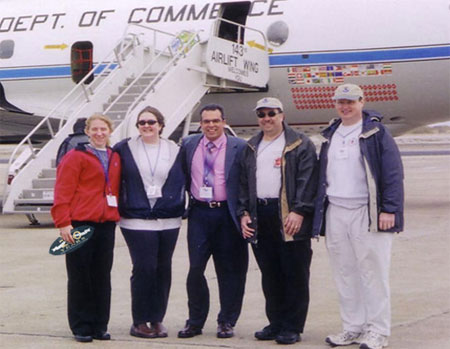 The National Weather Service in Taunton, Massachusetts, hosted
the first stop of the 2007 East Coast Hurricane Awareness Tour at Quonset State Airport in North Kingstown, Rhode Island. The purpose of the tour is to
increase hurricane awareness and to encourage preparedness in vulnerable coastal and inland communities through information stations, prescheduled briefings,
public tours of one of NOAA's Lockheed WP-3D Orion hurricane hunter aircraft, and visits with hurricane hunter crew members and National Hurricane Center -
Tropical Prediction Center staff members. Standing in front of the NOAA Hurricane Hunter Aircraft are (from left): Tracy McCormick, Jeane Wallace, David Vallee,
Edward Capone, and Jeff Ouellet.
The National Weather Service in Taunton, Massachusetts, hosted
the first stop of the 2007 East Coast Hurricane Awareness Tour at Quonset State Airport in North Kingstown, Rhode Island. The purpose of the tour is to
increase hurricane awareness and to encourage preparedness in vulnerable coastal and inland communities through information stations, prescheduled briefings,
public tours of one of NOAA's Lockheed WP-3D Orion hurricane hunter aircraft, and visits with hurricane hunter crew members and National Hurricane Center -
Tropical Prediction Center staff members. Standing in front of the NOAA Hurricane Hunter Aircraft are (from left): Tracy McCormick, Jeane Wallace, David Vallee,
Edward Capone, and Jeff Ouellet.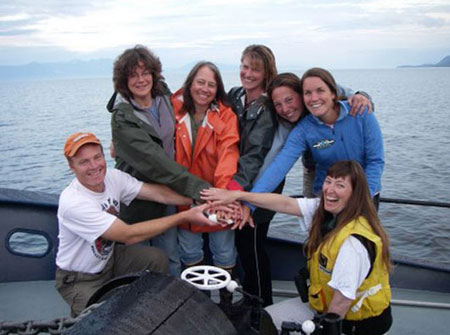 The Habitat Conservation Division of the NOAA Fisheries Alaska Region
supports a small team of scientific scuba divers to investigate habitat conditions in near shore locations throughout Alaska. This team, along with volunteer assistance of
divers from the University of Alaska - Fairbanks and the Alaska Fisheries Science Center - Auke Bay Laboratory, spent 12 days aboard the chartered research vessel Sundance
and conducted scuba surveys of eight log transfer facilities in southeast Alaska. The goal of the study was to assess the degree of recovery of the bark-smothered sea floor
at these heavily impacted sites. The crew here is celebrating the completion of a successful research cruise where SCUBA, trawling, fish trapping, and water quality information
was gathered at eight remote sites in the Alexander Archipelago of southeast Alaska. Pictured from left to right are: John Hudson, Sue Walker, Katharine Miller, Jennifer Mondragon,
Erika Ammann, Elizabeth Calvert, and Linda Shaw.
The Habitat Conservation Division of the NOAA Fisheries Alaska Region
supports a small team of scientific scuba divers to investigate habitat conditions in near shore locations throughout Alaska. This team, along with volunteer assistance of
divers from the University of Alaska - Fairbanks and the Alaska Fisheries Science Center - Auke Bay Laboratory, spent 12 days aboard the chartered research vessel Sundance
and conducted scuba surveys of eight log transfer facilities in southeast Alaska. The goal of the study was to assess the degree of recovery of the bark-smothered sea floor
at these heavily impacted sites. The crew here is celebrating the completion of a successful research cruise where SCUBA, trawling, fish trapping, and water quality information
was gathered at eight remote sites in the Alexander Archipelago of southeast Alaska. Pictured from left to right are: John Hudson, Sue Walker, Katharine Miller, Jennifer Mondragon,
Erika Ammann, Elizabeth Calvert, and Linda Shaw.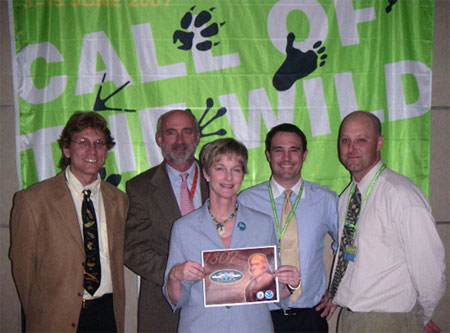 200th Celebration greeting from the Hague, Netherlands! U.S.
delegates from NOAA Fisheries Service presented listing proposals to protect sawfish, pink and red corals, and the Banggai cardinalfish from unsustainable
international trade during the 14th Conference of the Parties to the Convention on International Trade in Endangered Species (CITES). They also worked to
protect and regulate trade in other sharks, whales, and marine turtles at the Conference. In this photo, they are taking a few minutes to commemorate NOAA's
200th Celebration. Pictured are (from left): Andy Bruckner, David Cottingham, Nancy Daves, Ryan Wulff, and John Carlson.
200th Celebration greeting from the Hague, Netherlands! U.S.
delegates from NOAA Fisheries Service presented listing proposals to protect sawfish, pink and red corals, and the Banggai cardinalfish from unsustainable
international trade during the 14th Conference of the Parties to the Convention on International Trade in Endangered Species (CITES). They also worked to
protect and regulate trade in other sharks, whales, and marine turtles at the Conference. In this photo, they are taking a few minutes to commemorate NOAA's
200th Celebration. Pictured are (from left): Andy Bruckner, David Cottingham, Nancy Daves, Ryan Wulff, and John Carlson. On a beautiful June morning at Constitution Gardens on the National Mall in
Washington, DC, NOAA Fisheries volunteers helped 25 kids from Ross Elementary School learn about the glorious fun that is boating and fishing. The kids had a blast, and so did the
NOAA Fisheries volunteers! One of the kids jumped up and down with excitement at his 3" fish (which he then released) and shouted, "This is the best day of my whole life!"
The annual event is a collaboration of the National Park Service, the Department of the Interior, NOAA, DC Fisheries Program, and the non-profit Recreational Boating and Fishing
Foundation. Volunteers included Liz Fairey, Maile Bliss, Mark Oswell, Dianna Avery, Anne Isham, Mark Oswel, Arminta Brown, Shirley Lucas, Stephie Bost, Terry Sheriff, Chris German,
Brad Gentner, Jim McCallum, and Forbes Darby.
On a beautiful June morning at Constitution Gardens on the National Mall in
Washington, DC, NOAA Fisheries volunteers helped 25 kids from Ross Elementary School learn about the glorious fun that is boating and fishing. The kids had a blast, and so did the
NOAA Fisheries volunteers! One of the kids jumped up and down with excitement at his 3" fish (which he then released) and shouted, "This is the best day of my whole life!"
The annual event is a collaboration of the National Park Service, the Department of the Interior, NOAA, DC Fisheries Program, and the non-profit Recreational Boating and Fishing
Foundation. Volunteers included Liz Fairey, Maile Bliss, Mark Oswell, Dianna Avery, Anne Isham, Mark Oswel, Arminta Brown, Shirley Lucas, Stephie Bost, Terry Sheriff, Chris German,
Brad Gentner, Jim McCallum, and Forbes Darby.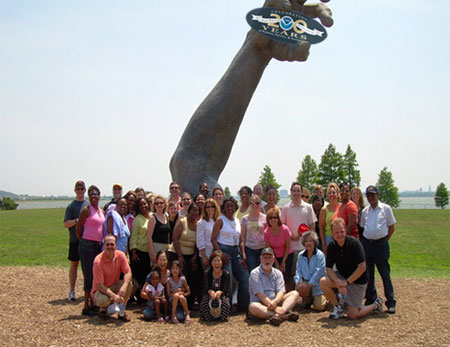 The NOAA Chief
Financial Officer (CFO) Office held a team-building exercise with its staff from the Finance and Budget Offices at East Point Park in Washington, DC. The Chief Financial Officer
serves as the principal financial manager for NOAA's resources. The CFO's Office is responsible for providing leadership necessary for NOAA to obtain a yearly-unqualified opinion in
the audit of its consolidated financial statements, as well as ensuring that NOAA's bills are paid in a timely manner. We are also responsible for the oversight and management of NOAA's
budget process, including coordinating the preparation of NOAA budget submissions to the Department, Office of Management and Budget, and the Congress.
The NOAA Chief
Financial Officer (CFO) Office held a team-building exercise with its staff from the Finance and Budget Offices at East Point Park in Washington, DC. The Chief Financial Officer
serves as the principal financial manager for NOAA's resources. The CFO's Office is responsible for providing leadership necessary for NOAA to obtain a yearly-unqualified opinion in
the audit of its consolidated financial statements, as well as ensuring that NOAA's bills are paid in a timely manner. We are also responsible for the oversight and management of NOAA's
budget process, including coordinating the preparation of NOAA budget submissions to the Department, Office of Management and Budget, and the Congress.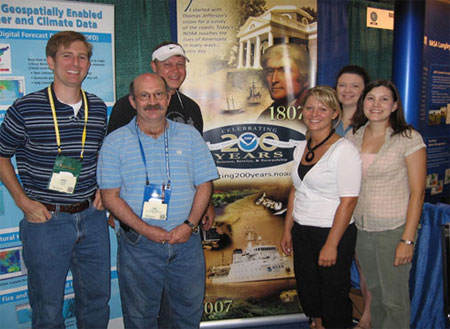 National
Weather Service Geographic Information Systems (GIS) users recently gathered at the 27th Annual ESRI International User Conference held in San Diego, California. The conference
offers information on new releases of GIS software, access to specialists within the company for product and technical support, moderated paper sessions on the use of GIS in a
variety of disciplines, training sessions, and an exhibit area containing booths from industry and government. NOAA had a booth this year staffed by volunteers from all of the
NOAA line offices including the National Weather Service. Numerous National Weather Service data sets are available in GIS compatible formats. Pictured in the NOAA booth are:
Kris Lander, Ira Graffman, Keith Stellman, Becky Griffis, Kari Sheets and Jenna Meyers. Not pictured but participating in the conference: Ken Waters, Jack Settelmeier, Cass
Goodman and Mark Jackson.
National
Weather Service Geographic Information Systems (GIS) users recently gathered at the 27th Annual ESRI International User Conference held in San Diego, California. The conference
offers information on new releases of GIS software, access to specialists within the company for product and technical support, moderated paper sessions on the use of GIS in a
variety of disciplines, training sessions, and an exhibit area containing booths from industry and government. NOAA had a booth this year staffed by volunteers from all of the
NOAA line offices including the National Weather Service. Numerous National Weather Service data sets are available in GIS compatible formats. Pictured in the NOAA booth are:
Kris Lander, Ira Graffman, Keith Stellman, Becky Griffis, Kari Sheets and Jenna Meyers. Not pictured but participating in the conference: Ken Waters, Jack Settelmeier, Cass
Goodman and Mark Jackson.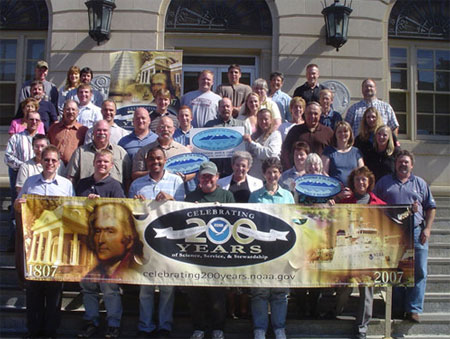 Following a severe weather safety presentation
by John Paul Martin (holding banner at the far left), Warning Coordination Meteorologist at NOAA's National Weather Service in Bismarck, North Dakota, personnel
from the Department of the Interior's Bureau of Reclamation joined in commemorating NOAA's celebration of 200 years of Science, Service, and Stewardship at the
bureau's Bismarck office.
Following a severe weather safety presentation
by John Paul Martin (holding banner at the far left), Warning Coordination Meteorologist at NOAA's National Weather Service in Bismarck, North Dakota, personnel
from the Department of the Interior's Bureau of Reclamation joined in commemorating NOAA's celebration of 200 years of Science, Service, and Stewardship at the
bureau's Bismarck office.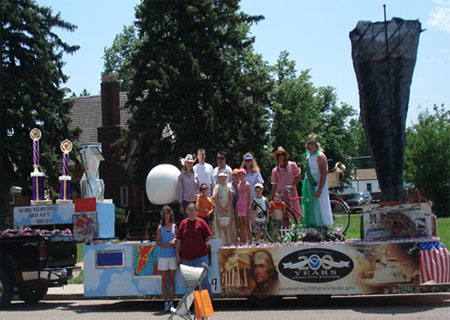 The National Weather Service in North Platte, Nebraska,
entered a float in the NEBRASKAland Days Parade this year. The theme of the parade was "The Tradition Rides On" as NEBRASKAland Days was celebrating 125 years. The National Weather Service
office won first prize in the Commercial Float division and also took home the Best Float Overall. The float highlighted the arrival of the National Weather Service in North Platte in 1874,
the first weather satellite in 1960, the first weather radar in 1942, and the first tornado warning was in 1947. The float also showcased NOAA's 200th celebration of Science, Service and
Stewardship. Pictured (top, from left) Christina Henderson; Bill Taylor; Brian Hirsch; Teresa Keck; Dennis Phillips (as Dorothy in the Wizard of Oz); and Jim Sweet (as Glenda the good
witch of the North in the Wizard of Oz); National Weather Service employee's children, James, Leela, Jamie, Samantha, Alex, and Landon. Standing in front of the float (from left): Deb
Blondin and Angela Oder.
The National Weather Service in North Platte, Nebraska,
entered a float in the NEBRASKAland Days Parade this year. The theme of the parade was "The Tradition Rides On" as NEBRASKAland Days was celebrating 125 years. The National Weather Service
office won first prize in the Commercial Float division and also took home the Best Float Overall. The float highlighted the arrival of the National Weather Service in North Platte in 1874,
the first weather satellite in 1960, the first weather radar in 1942, and the first tornado warning was in 1947. The float also showcased NOAA's 200th celebration of Science, Service and
Stewardship. Pictured (top, from left) Christina Henderson; Bill Taylor; Brian Hirsch; Teresa Keck; Dennis Phillips (as Dorothy in the Wizard of Oz); and Jim Sweet (as Glenda the good
witch of the North in the Wizard of Oz); National Weather Service employee's children, James, Leela, Jamie, Samantha, Alex, and Landon. Standing in front of the float (from left): Deb
Blondin and Angela Oder.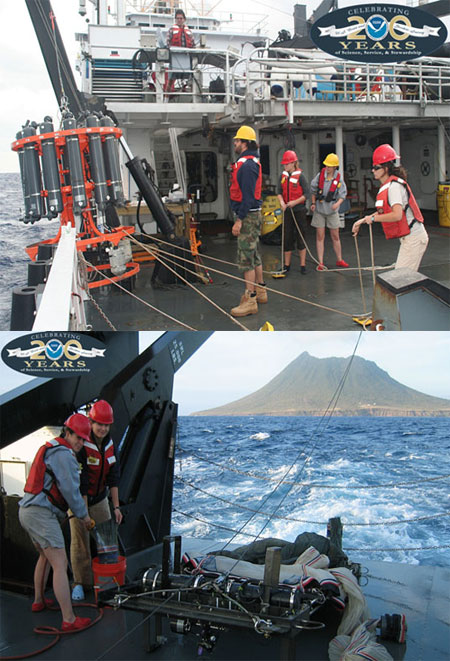 NOAA
scientists with Atlantic Oceanographic and Meteorological Laboratory's Physical Oceanography Division and the National Marine Fisheries Service Southeast Fisheries Science Center partnered in a
joint research cruise aboard the NOAA Ship Nancy Foster this past March-April 2007 to gather biological and physical oceanographic data from the coastal waters of the Virgin Islands and surrounding
region. Students and faculty from the University of the Virgin Islands also participated on the cruise. The collaborative research cruise was part of a new three-year interdisciplinary research
project aimed at examining how recruitment of larval reef fish in the Virgin Islands and the surrounding area is affected by local oceanographic processes and how the different shallow banks
found in the northeastern Caribbean are ecologically linked via dispersal of these larvae. Pictured (top photo, from left): Dave Leaphart, Grant Rawson, Ashly Beebe, Natasha Davis, and Estrella
Malca; (bottom photo, from left): Natasha Davis and Estrella Malca.
NOAA
scientists with Atlantic Oceanographic and Meteorological Laboratory's Physical Oceanography Division and the National Marine Fisheries Service Southeast Fisheries Science Center partnered in a
joint research cruise aboard the NOAA Ship Nancy Foster this past March-April 2007 to gather biological and physical oceanographic data from the coastal waters of the Virgin Islands and surrounding
region. Students and faculty from the University of the Virgin Islands also participated on the cruise. The collaborative research cruise was part of a new three-year interdisciplinary research
project aimed at examining how recruitment of larval reef fish in the Virgin Islands and the surrounding area is affected by local oceanographic processes and how the different shallow banks
found in the northeastern Caribbean are ecologically linked via dispersal of these larvae. Pictured (top photo, from left): Dave Leaphart, Grant Rawson, Ashly Beebe, Natasha Davis, and Estrella
Malca; (bottom photo, from left): Natasha Davis and Estrella Malca.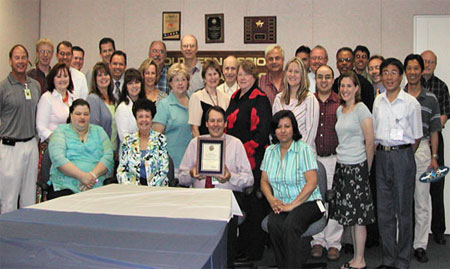 NOAA's National Weather Service Southern
Region Acting Director Steven Cooper gathered his headquarters staff together recently to celebrate their Department of Commerce Bronze Medal. Also on hand were visiting meteorologists
from the People's Republic of China. The Chinese meteorologists have been visiting local, regional and national centers as part of an international exchange agreement with the National
Weather Service. The headquarters staff has been recognized for leadership and support for National Weather Service field office warning and forecast operations during the 2005 hurricane
season. The headquarters employees provided indispensable administrative, logistical, and technical support to the offices. Their leadership and actions assisted the offices in preparing
for, delivering, and sustaining critical forecast and warning operations prior to, during, and in the aftermath of the storms.
NOAA's National Weather Service Southern
Region Acting Director Steven Cooper gathered his headquarters staff together recently to celebrate their Department of Commerce Bronze Medal. Also on hand were visiting meteorologists
from the People's Republic of China. The Chinese meteorologists have been visiting local, regional and national centers as part of an international exchange agreement with the National
Weather Service. The headquarters staff has been recognized for leadership and support for National Weather Service field office warning and forecast operations during the 2005 hurricane
season. The headquarters employees provided indispensable administrative, logistical, and technical support to the offices. Their leadership and actions assisted the offices in preparing
for, delivering, and sustaining critical forecast and warning operations prior to, during, and in the aftermath of the storms.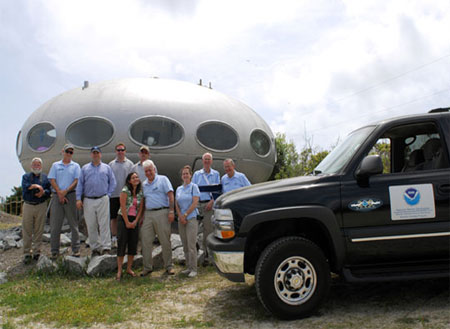 The Monitor
National Marine Sanctuary's Advisory Council (SAC) recently gathered for meetings in Cape Hatteras, North Carolina. While the wreck of the USS Monitor was the main item
on the agenda, participants also were given briefings on the biological, environmental, and historical aspects of the area aptly known as the Graveyard of the Atlantic.
Here SAC members, staff from the Monitor National Marine Sanctuary, and members of the Maritime Heritage Program examine one of the "anomalies" that has been attributed
to some of the mysterious losses of ships in the Graveyard's waters. Pictured (from left): (back) Wayne Smith, Richard Lawrence, David Alberg, Tane Casserley, Jeff
Johnston, (front) Krista Trono, Don Reynolds, Susan Langley, Dr. Tim Runyan, and Channing Zucker.
The Monitor
National Marine Sanctuary's Advisory Council (SAC) recently gathered for meetings in Cape Hatteras, North Carolina. While the wreck of the USS Monitor was the main item
on the agenda, participants also were given briefings on the biological, environmental, and historical aspects of the area aptly known as the Graveyard of the Atlantic.
Here SAC members, staff from the Monitor National Marine Sanctuary, and members of the Maritime Heritage Program examine one of the "anomalies" that has been attributed
to some of the mysterious losses of ships in the Graveyard's waters. Pictured (from left): (back) Wayne Smith, Richard Lawrence, David Alberg, Tane Casserley, Jeff
Johnston, (front) Krista Trono, Don Reynolds, Susan Langley, Dr. Tim Runyan, and Channing Zucker.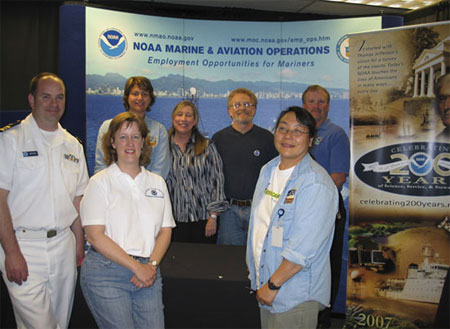 After months of planning Seattle's NOAA 200th celebration event, the
"Get to Know NOAA Weekend" was held in June in conjunction with the "Treasures of NOAA's Ark" exhibit at the Pacific Science Center in Seattle, Washington, featuring
activities, exhibits, and talks by NOAA scientists. Hundreds of visitors stopped by the "Meet a NOAA Scientist" area where booths from a variety of NOAA offices were
set up to answer questions and inform the visitors about their role within NOAA. Pictured in the "Meet a NOAA Scientist" exhibit are (front row, from left): LCDR Mike
Hopkins, Helen Bottcher, and Lisa Hiruki-Raring. (Back row, from left): Rebecca Reuter, Liz Clarke, Jeff Napp, and Ted Buehner.
After months of planning Seattle's NOAA 200th celebration event, the
"Get to Know NOAA Weekend" was held in June in conjunction with the "Treasures of NOAA's Ark" exhibit at the Pacific Science Center in Seattle, Washington, featuring
activities, exhibits, and talks by NOAA scientists. Hundreds of visitors stopped by the "Meet a NOAA Scientist" area where booths from a variety of NOAA offices were
set up to answer questions and inform the visitors about their role within NOAA. Pictured in the "Meet a NOAA Scientist" exhibit are (front row, from left): LCDR Mike
Hopkins, Helen Bottcher, and Lisa Hiruki-Raring. (Back row, from left): Rebecca Reuter, Liz Clarke, Jeff Napp, and Ted Buehner.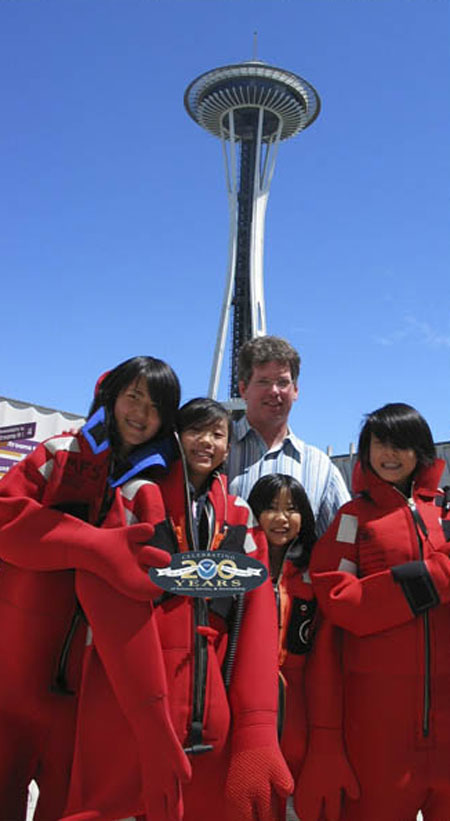 After months of planning Seattle's NOAA 200th celebration event, the "Get to Know NOAA Weekend"
was held in June in conjunction with the "Treasures of NOAA's Ark" exhibit at the Pacific Science Center in Seattle, Washington, featuring activities, exhibits, and
talks by NOAA scientists. Hundreds of visitors stopped by the "Meet a NOAA Scientist" area where booths from a variety of NOAA offices were set up to answer questions
and inform the visitors about their role within NOAA. This photo shows Ken Kruse with a few youth who stopped by to see the "Survival at Sea" demonstration with
Seattle's Space Needle in the background.
After months of planning Seattle's NOAA 200th celebration event, the "Get to Know NOAA Weekend"
was held in June in conjunction with the "Treasures of NOAA's Ark" exhibit at the Pacific Science Center in Seattle, Washington, featuring activities, exhibits, and
talks by NOAA scientists. Hundreds of visitors stopped by the "Meet a NOAA Scientist" area where booths from a variety of NOAA offices were set up to answer questions
and inform the visitors about their role within NOAA. This photo shows Ken Kruse with a few youth who stopped by to see the "Survival at Sea" demonstration with
Seattle's Space Needle in the background.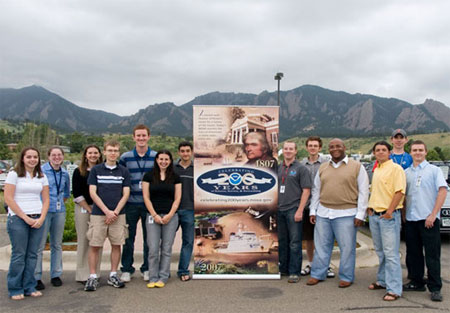 Greetings from Boulder, Colorado! NOAA's David Skaggs
Research Center hosts student workers every year, and pictured here are this year's group including scholars from the Hollings Undergraduate Scholarship Program,
the Educational Partnership Program, and other scholarship programs. Students in Boulder come from a broad range of educational backgrounds and are working on a
fascinating array of projects, including paleoclimatology research, engineering, space weather, computer programming, and education and outreach. Students will
present their summer projects and findings to their colleagues during a three-day seminar at the end of the summer. Pictured (from left): Melissa Payer, Katherine
Pingree, Colleen Heck, Sean Boocock, Greg Seroka, Ilissa Ocko, Adam Greenbaum, Jonathan Splitt, Stavros Calos, Gregory Woodall, Ryan Neely, Stephen Wilfong, and Scott
Miller. Not Pictured: Corinne D'Ippolito, Kelli Hoover, Tristan Baruth, Michael Rhodes, Jason Seiler, Yiming Wang, Zachary Whitfield, Phillip Stauffer, and
Malcolm Young.
Greetings from Boulder, Colorado! NOAA's David Skaggs
Research Center hosts student workers every year, and pictured here are this year's group including scholars from the Hollings Undergraduate Scholarship Program,
the Educational Partnership Program, and other scholarship programs. Students in Boulder come from a broad range of educational backgrounds and are working on a
fascinating array of projects, including paleoclimatology research, engineering, space weather, computer programming, and education and outreach. Students will
present their summer projects and findings to their colleagues during a three-day seminar at the end of the summer. Pictured (from left): Melissa Payer, Katherine
Pingree, Colleen Heck, Sean Boocock, Greg Seroka, Ilissa Ocko, Adam Greenbaum, Jonathan Splitt, Stavros Calos, Gregory Woodall, Ryan Neely, Stephen Wilfong, and Scott
Miller. Not Pictured: Corinne D'Ippolito, Kelli Hoover, Tristan Baruth, Michael Rhodes, Jason Seiler, Yiming Wang, Zachary Whitfield, Phillip Stauffer, and
Malcolm Young.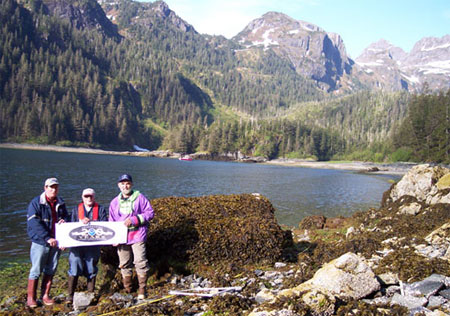 Early each summer,
NOAA Emergency Response Division (ERD) scientists conduct one or more surveys of shorelines in western Prince William Sound, Alaska, to document recovery following the
March 24, 1989, Exxon Valdez oil spill. From 1989 to 2000, teams of up to 12 scientists and contract biologists conducted detailed quantitative sampling of the biota and
chemistry of un-oiled and oiled shorelines, including several "Set Aside" shorelines that were not subject to high energy cleaning. Since 2001 a smaller team has continued to
conduct photo, wildlife, oiling and site-maintenance surveys, resulting in 18 years of time series photos and qualitative data on the declining presence of oil. Local citizens
often accompany the ERD scientists on their three- to four-day surveys. During the past two years, the ERD team has also joined with local organizations to participate in
marine debris cleanup and monitoring. Pictured (from left): John Whitney, Alaska Scientific Support Coordinator; John Tarpley, Regional Operations Coordinator; and Alan Mearns,
Senior Staff Scientist.
Early each summer,
NOAA Emergency Response Division (ERD) scientists conduct one or more surveys of shorelines in western Prince William Sound, Alaska, to document recovery following the
March 24, 1989, Exxon Valdez oil spill. From 1989 to 2000, teams of up to 12 scientists and contract biologists conducted detailed quantitative sampling of the biota and
chemistry of un-oiled and oiled shorelines, including several "Set Aside" shorelines that were not subject to high energy cleaning. Since 2001 a smaller team has continued to
conduct photo, wildlife, oiling and site-maintenance surveys, resulting in 18 years of time series photos and qualitative data on the declining presence of oil. Local citizens
often accompany the ERD scientists on their three- to four-day surveys. During the past two years, the ERD team has also joined with local organizations to participate in
marine debris cleanup and monitoring. Pictured (from left): John Whitney, Alaska Scientific Support Coordinator; John Tarpley, Regional Operations Coordinator; and Alan Mearns,
Senior Staff Scientist.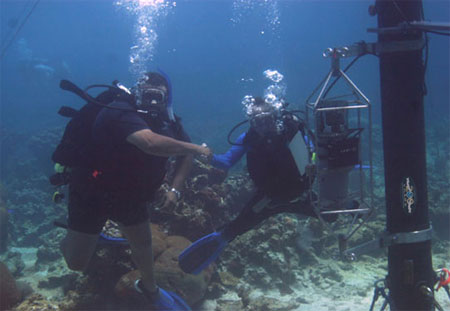 For several years, scientists with NOAA's Integrated Coral Observing Network (ICON) at the
Atlantic Oceanographic and Meteorological Laboratory (AOML) in Miami, Florida, have been working closely with the World Bank, Global Environmental Facility, and the Caribbean Community Secretariat
to install a Coral Reef Early Warning System (CREWS) station just offshore of the Discovery Bay Marine Laboratory, Jamaica. CREWS stations within the ICON Network of over 120 monitoring sites
gather near real-time meteorological and oceanographic data at environmentally sensitive coral reef areas, then telemeter the data back to AOML via a GOES satellite. The data are then integrated
with satellite and other data sources (such as radar) to support the development of ecological forecasts, such as coral bleaching and upwelling, which will be of use to Marine Protected Area and
research personnel for years to come. Shown here are Peter Gayle (left), Principal Research of DBML, as he meets Dr. Jim Hendee, ICON Program Manager, at the moment of final completion of the
CREWS station with a well-earned handshake on a job well-done by both teams.
For several years, scientists with NOAA's Integrated Coral Observing Network (ICON) at the
Atlantic Oceanographic and Meteorological Laboratory (AOML) in Miami, Florida, have been working closely with the World Bank, Global Environmental Facility, and the Caribbean Community Secretariat
to install a Coral Reef Early Warning System (CREWS) station just offshore of the Discovery Bay Marine Laboratory, Jamaica. CREWS stations within the ICON Network of over 120 monitoring sites
gather near real-time meteorological and oceanographic data at environmentally sensitive coral reef areas, then telemeter the data back to AOML via a GOES satellite. The data are then integrated
with satellite and other data sources (such as radar) to support the development of ecological forecasts, such as coral bleaching and upwelling, which will be of use to Marine Protected Area and
research personnel for years to come. Shown here are Peter Gayle (left), Principal Research of DBML, as he meets Dr. Jim Hendee, ICON Program Manager, at the moment of final completion of the
CREWS station with a well-earned handshake on a job well-done by both teams.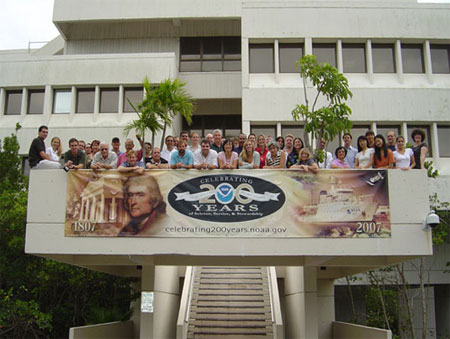 In Miami, Florida, the Physical Oceanography Division of
NOAA's Atlantic Oceanographic and Meteorological Laboratory (AOML) poses for a rare group photo outside of AOML that includes staff from as far as Spain; Seattle,
Washington; San Diego, California; Silver Spring, Maryland; Norfolk, Virginia; and summer students from Puerto Rico. The occasion was the annual meeting of the AOML
Ship of Opportunity program. This program involves the global deployment of temperature probes from commercial and research vessels, and related data transmission,
quality control and distribution. AOML's Physical Oceanography Division (PhOD) conducts interdisciplinary studies to determine the role of the ocean in short- and
long-term climate change and weather, as well as provides data analyzes and assimilation tools for ocean prediction. PhOD also houses a Global Ocean Observing System
Center which manages the operational data collection activities of programs such as Argo (U.S. deployed Atlantic floats) and the Global Drifter Program, as well as
multiple sources of temperature and surface salinity data.
In Miami, Florida, the Physical Oceanography Division of
NOAA's Atlantic Oceanographic and Meteorological Laboratory (AOML) poses for a rare group photo outside of AOML that includes staff from as far as Spain; Seattle,
Washington; San Diego, California; Silver Spring, Maryland; Norfolk, Virginia; and summer students from Puerto Rico. The occasion was the annual meeting of the AOML
Ship of Opportunity program. This program involves the global deployment of temperature probes from commercial and research vessels, and related data transmission,
quality control and distribution. AOML's Physical Oceanography Division (PhOD) conducts interdisciplinary studies to determine the role of the ocean in short- and
long-term climate change and weather, as well as provides data analyzes and assimilation tools for ocean prediction. PhOD also houses a Global Ocean Observing System
Center which manages the operational data collection activities of programs such as Argo (U.S. deployed Atlantic floats) and the Global Drifter Program, as well as
multiple sources of temperature and surface salinity data.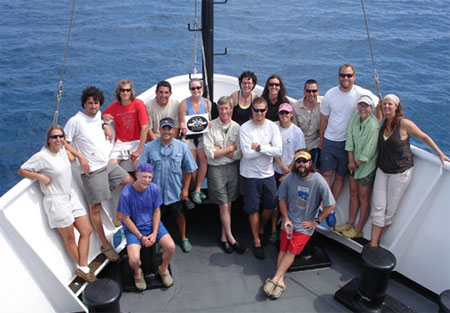 For the past four
years, researchers from NOAA's Center for Coastal Fisheries and Habitat Research have conducted an annual research cruise aboard NOAA Ship Nancy Foster to Puerto Rico
and Isla Vieques with the help of participants from other NOAA Line Offices and academic institutions. The purpose of this cruise is an ongoing investigation of the
response of seagrass beds to physical disturbances including boat groundings, storms, wave energy, and foraging areas. This year's cruise included participants from
NOAA's Southeast Fisheries Science Center, NOAA's Office of Response and Restoration, and the North Carolina State University. Pictured in the bow of Nancy Foster
are (from left): Tracy Hamburger, Chris Taylor, Jud Kenworthy (seated), Sean Meehan, Todd Kellison, Giuseppe Di Carlo, Jenny Vander Pluym, John Burke, Erika Hansen,
Brian Degan, Missy Partyka, Paula Whitfield, Kevin Kirsch, Warren Mitchell, Amy Uhrin, Brooke Landry and John Hackney (seated).
For the past four
years, researchers from NOAA's Center for Coastal Fisheries and Habitat Research have conducted an annual research cruise aboard NOAA Ship Nancy Foster to Puerto Rico
and Isla Vieques with the help of participants from other NOAA Line Offices and academic institutions. The purpose of this cruise is an ongoing investigation of the
response of seagrass beds to physical disturbances including boat groundings, storms, wave energy, and foraging areas. This year's cruise included participants from
NOAA's Southeast Fisheries Science Center, NOAA's Office of Response and Restoration, and the North Carolina State University. Pictured in the bow of Nancy Foster
are (from left): Tracy Hamburger, Chris Taylor, Jud Kenworthy (seated), Sean Meehan, Todd Kellison, Giuseppe Di Carlo, Jenny Vander Pluym, John Burke, Erika Hansen,
Brian Degan, Missy Partyka, Paula Whitfield, Kevin Kirsch, Warren Mitchell, Amy Uhrin, Brooke Landry and John Hackney (seated). Promoting environmental literacy is essential to support NOAA's mission
and one way we do that is through internship programs that provide the opportunity for hundreds of young scholars to work side by side with NOAA scientists. This year,
more than 120 students from three separate programs - the Ernest F. Hollings Undergraduate Scholars, the Educational Partnership Program (EPP) Undergraduate Scholars,
and the EPP Graduate Scholars - traveled to Silver Spring, Maryland, for a very busy introduction to NOAA.
Promoting environmental literacy is essential to support NOAA's mission
and one way we do that is through internship programs that provide the opportunity for hundreds of young scholars to work side by side with NOAA scientists. This year,
more than 120 students from three separate programs - the Ernest F. Hollings Undergraduate Scholars, the Educational Partnership Program (EPP) Undergraduate Scholars,
and the EPP Graduate Scholars - traveled to Silver Spring, Maryland, for a very busy introduction to NOAA.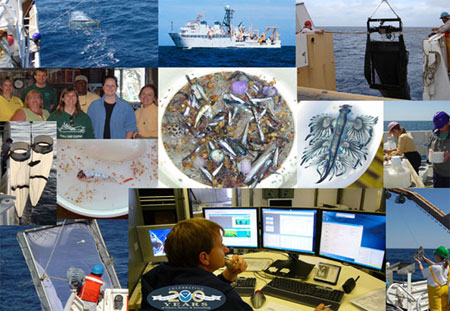 The scientists and crew aboard the NOAA Ship GORDON GUNTER completed an
intensive SEAMAP winter survey of ichthyoplankton in the eastern Gulf of Mexico from the De Soto Canyon to the Straits of Florida. Survey objectives were to assess and
measure the occurrence, abundance, vertical distribution, and pelagic habitat of the early life stages of winter spawning fishes (especially the groupers) from
mid-continental shelf to deep Gulf waters. Among the non-standard collecting gear used during this cruise were a Methot juvenile fish trawl (lower left panel) and a
one-meter MOCNESS (upper right panel) which was loaned to the SEFSC/Mississippi Laboratories by the NEFSC/Narragansett Laboratory. Sampling with the MOCNESS resulted
in the most extensive set of discrete depth plankton samples ever collected in the region and a rare expedition into the Gulf of Mexico during winter months. A diverse
array of organisms were captured such as a young Dealfish, Trachipterus arcticus (middle left panel); neustonic fishes and invertebrates (center panel); and the pelagic
blue nudibranch, Glaucus atlanticus (middle right panel). Scientific party pictured in upper left panel include: Front row - Pam Bond, Kim Williams, Denice Drass,
Christina Schobernd and Joanne Lyczkowski-Shultz; Back row - Glenn Zapfe and Alonzo Hamilton.
The scientists and crew aboard the NOAA Ship GORDON GUNTER completed an
intensive SEAMAP winter survey of ichthyoplankton in the eastern Gulf of Mexico from the De Soto Canyon to the Straits of Florida. Survey objectives were to assess and
measure the occurrence, abundance, vertical distribution, and pelagic habitat of the early life stages of winter spawning fishes (especially the groupers) from
mid-continental shelf to deep Gulf waters. Among the non-standard collecting gear used during this cruise were a Methot juvenile fish trawl (lower left panel) and a
one-meter MOCNESS (upper right panel) which was loaned to the SEFSC/Mississippi Laboratories by the NEFSC/Narragansett Laboratory. Sampling with the MOCNESS resulted
in the most extensive set of discrete depth plankton samples ever collected in the region and a rare expedition into the Gulf of Mexico during winter months. A diverse
array of organisms were captured such as a young Dealfish, Trachipterus arcticus (middle left panel); neustonic fishes and invertebrates (center panel); and the pelagic
blue nudibranch, Glaucus atlanticus (middle right panel). Scientific party pictured in upper left panel include: Front row - Pam Bond, Kim Williams, Denice Drass,
Christina Schobernd and Joanne Lyczkowski-Shultz; Back row - Glenn Zapfe and Alonzo Hamilton.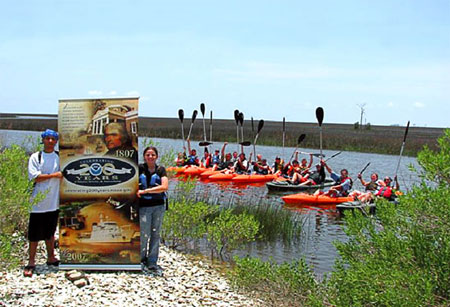 This group of Americorps volunteers from
northern Colorado called the Colorado Range Riders was assigned to help restore a portion of southern Mississippi impacted by Hurricane Katrina. After participating
in three days of coastal cleanups and weeks of restoring damaged homes, these hard-working young adults were rewarded with an educational/recreational kayak tour of
the Grand Bay National Estuarine Research Reserve. These young leaders of tomorrow had a great time while learning the importance of conserving coastal habitats.
This group of Americorps volunteers from
northern Colorado called the Colorado Range Riders was assigned to help restore a portion of southern Mississippi impacted by Hurricane Katrina. After participating
in three days of coastal cleanups and weeks of restoring damaged homes, these hard-working young adults were rewarded with an educational/recreational kayak tour of
the Grand Bay National Estuarine Research Reserve. These young leaders of tomorrow had a great time while learning the importance of conserving coastal habitats.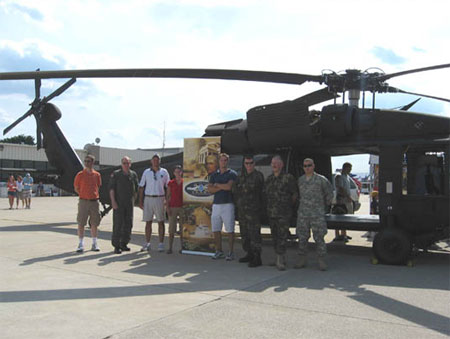 200th Celebration greetings from northern Indiana,
southwest Michigan, and northwest Ohio! NOAA's National Weather Service Northern Indiana office commemorated NOAA's 200th celebration at the airport with fireworks! Goshen Freedom Fest
was held on June 30th at the Goshen Indiana Airport. An estimated 25,000 to 30,000 people attended the day-long event. Staff from NOAA's National Weather Service Northern Indiana office
set up an information and display booth, complete with posters, brochures, and a NOAA Weather Radio All Hazards display. The staff kept busy during the day answering numerous questions
from the crowd about weather safety, aviation weather, NOAA Weather Radio All Hazards, and NOAA's 200th Celebration. In the photo, Senior Meteorologists John Taylor and Sam Lashley,
along with SCEP Sara Weisser and Intern B.J. Simpson, pose for a picture with the crew of a Blackhawk Helicopter, from the 38th Aviation Battalion based in Shelbyville.
200th Celebration greetings from northern Indiana,
southwest Michigan, and northwest Ohio! NOAA's National Weather Service Northern Indiana office commemorated NOAA's 200th celebration at the airport with fireworks! Goshen Freedom Fest
was held on June 30th at the Goshen Indiana Airport. An estimated 25,000 to 30,000 people attended the day-long event. Staff from NOAA's National Weather Service Northern Indiana office
set up an information and display booth, complete with posters, brochures, and a NOAA Weather Radio All Hazards display. The staff kept busy during the day answering numerous questions
from the crowd about weather safety, aviation weather, NOAA Weather Radio All Hazards, and NOAA's 200th Celebration. In the photo, Senior Meteorologists John Taylor and Sam Lashley,
along with SCEP Sara Weisser and Intern B.J. Simpson, pose for a picture with the crew of a Blackhawk Helicopter, from the 38th Aviation Battalion based in Shelbyville.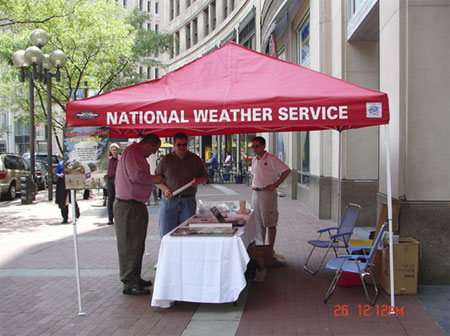 In June, the Indianapolis Weather Forecast Office (WFO) hosted a
lightning safety awareness week event on Monument Circle in downtown Indianapolis, Indiana. Meteorologists from the WFO distributed lightning safety posters, magnets, brochures, and golf
tees, as well as answered questions from the public and an interview from WIBC Radio news. Shown under the awning (from left): an interested citizen and National Weather Service meteorologists
Joseph Nield and Jason Puma.
In June, the Indianapolis Weather Forecast Office (WFO) hosted a
lightning safety awareness week event on Monument Circle in downtown Indianapolis, Indiana. Meteorologists from the WFO distributed lightning safety posters, magnets, brochures, and golf
tees, as well as answered questions from the public and an interview from WIBC Radio news. Shown under the awning (from left): an interested citizen and National Weather Service meteorologists
Joseph Nield and Jason Puma.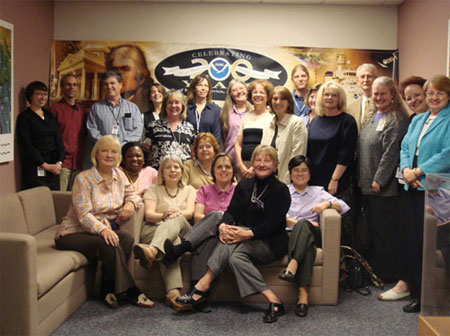 Librarians take time out from the books to
send greetings from the Annual NOAA Libraries Conference in Silver Spring, Maryland. NOAA has 31 libraries encompassing some of the largest environmental science collections on
Earth that serve NOAA operations, research, and policy offices at NOAA facilities from Kodiak Island to Miami and from Woods Hole to Honolulu. NOAA Libraries have served NOAA personnel
from Antarctica to the Alaskan Arctic and even have provided information to NOAA ships at sea. Pictured are (seated, front row, from left): Linda Pikula, Lagena Fantroy, Kathy Kelly,
Maria Bello, Lisa Pugh, Janice Beattie, and Earie Taniuchi; (Back row, from left): Michelle Campbell, Brian Voss, Skip Theberge, Liselle Drake, Linda Salyers, Caroline Woods,
Paula Jonson, Eileen McVey, Gloria Aversano, Nick Berry, Ginny Dietrich, Claire Steimle, Neal Kaske, Debra Losey, Anna Fiolek, and Doria Grimes.
Librarians take time out from the books to
send greetings from the Annual NOAA Libraries Conference in Silver Spring, Maryland. NOAA has 31 libraries encompassing some of the largest environmental science collections on
Earth that serve NOAA operations, research, and policy offices at NOAA facilities from Kodiak Island to Miami and from Woods Hole to Honolulu. NOAA Libraries have served NOAA personnel
from Antarctica to the Alaskan Arctic and even have provided information to NOAA ships at sea. Pictured are (seated, front row, from left): Linda Pikula, Lagena Fantroy, Kathy Kelly,
Maria Bello, Lisa Pugh, Janice Beattie, and Earie Taniuchi; (Back row, from left): Michelle Campbell, Brian Voss, Skip Theberge, Liselle Drake, Linda Salyers, Caroline Woods,
Paula Jonson, Eileen McVey, Gloria Aversano, Nick Berry, Ginny Dietrich, Claire Steimle, Neal Kaske, Debra Losey, Anna Fiolek, and Doria Grimes.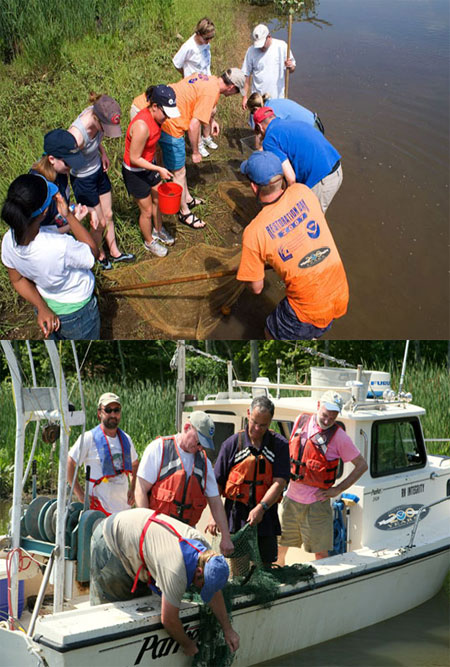 On June 12, hundreds of NOAA employees and partners
participated in the 4th annual NOAA Restoration Day in Maryland and Virginia. NOAA Restoration Day is one of the largest voluntary federal-employee-sponsored environmental stewardship events
in the Bay watershed. The Maryland event was held at the Jug Bay component of the Chesapeake Bay National Estuarine Research Reserve in Maryland and the Virginia event was held at the Virginia
Commonwealth University Rice Center in Charles City, Virginia. At Jug Bay, more than 170 NOAA volunteers from all NOAA line offices joined staff from partner agencies to restore a portion of the
Patuxent River. Volunteers planted underwater grasses grown in 22 tanks in NOAA offices, transplanted wild rice, performed fish seining and sampling, mapped and removed invasive plants, completed
digital elevation mapping, and more. More information can be found at http://restorationday.noaa.gov.
On June 12, hundreds of NOAA employees and partners
participated in the 4th annual NOAA Restoration Day in Maryland and Virginia. NOAA Restoration Day is one of the largest voluntary federal-employee-sponsored environmental stewardship events
in the Bay watershed. The Maryland event was held at the Jug Bay component of the Chesapeake Bay National Estuarine Research Reserve in Maryland and the Virginia event was held at the Virginia
Commonwealth University Rice Center in Charles City, Virginia. At Jug Bay, more than 170 NOAA volunteers from all NOAA line offices joined staff from partner agencies to restore a portion of the
Patuxent River. Volunteers planted underwater grasses grown in 22 tanks in NOAA offices, transplanted wild rice, performed fish seining and sampling, mapped and removed invasive plants, completed
digital elevation mapping, and more. More information can be found at http://restorationday.noaa.gov.
